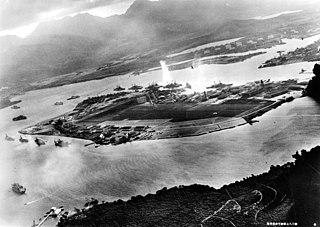
Artillery is a class of heavy military ranged weapons built to launch munitions far beyond the range and power of infantry's small arms. Early artillery development focused on the ability to breach defensive walls and fortifications during sieges, and led to heavy, fairly immobile siege engines. As technology improved, lighter, more mobile field artillery cannons developed for battlefield use. This development continues today; modern self-propelled artillery vehicles are highly mobile weapons of great versatility providing the large share of an army's total firepower.

The Lockheed AC-130 gunship is a heavily armed, long-endurance ground-attack variant of the C-130 Hercules transport fixed-wing aircraft. It carries a wide array of anti-ground oriented weapons that are integrated with sophisticated sensors, navigation, and fire-control systems. Unlike other military fixed-wing aircraft, the AC-130 relies on visual targeting. Because its large profile and low operating altitudes make it an easy target, it usually flies close air support missions at night.

The Tomahawk Land Attack Missile (TLAM) is a long-range, all-weather, subsonic cruise missile that is primarily used by the United States Navy and Royal Navy in ship and submarine-based land-attack operations. Introduced by General Dynamics in the 1970s, it was initially designed as a medium- to long-range, low-altitude missile that could be launched from a surface platform. Since then, it has been upgraded several times with guidance systems for precision navigation. In 1992–1994, McDonnell Douglas Corporation was the sole supplier of Tomahawk Missiles and produced Block II and Block III Tomahawk missiles and remanufactured many Tomahawks to Block III specifications. In 1994, Hughes outbid McDonnell Douglas Aerospace to become the sole supplier of Tomahawk missiles. It is now manufactured by Raytheon. In 2016, the U.S. Department of Defense purchased 149 Tomahawk Block IV missiles for $202.3 million.

The Attack on Pearl Harbor was a surprise military strike by the Imperial Japanese Navy Air Service upon the United States against the naval base at Pearl Harbor in Honolulu, Hawaii on Sunday morning, December 7, 1941. The attack led to the United States' formal entry into World War II the next day. The Japanese military leadership referred to the attack as the Hawaii Operation and Operation AI, and as Operation Z during its planning.

The Phalanx CIWS is a close-in weapon system for defense against anti-ship missiles, helicopters, etc. It was designed and manufactured by the General Dynamics Corporation, Pomona Division. Consisting of a radar-guided 20 mm Vulcan cannon mounted on a swiveling base, the Phalanx has been used by multiple navies around the world, notably the U.S. Navy on every class of surface combat ship with the exception of the San Antonio-class LPD, by the Canadian Royal Canadian Navy, the British Royal Navy, and by the U.S. Coast Guard aboard its Hamilton and Legend-class cutters. The Phalanx is used by 15 other allied nations.

An air-to-air missile (AAM) is a missile fired from an aircraft for the purpose of destroying another aircraft. AAMs are typically powered by one or more rocket motors, usually solid fueled but sometimes liquid fueled. Ramjet engines, as used on the Meteor (missile) are emerging as propulsion that will enable future medium-range missiles to maintain higher average speed across their engagement envelope.

The P-15 Termit is an anti-ship missile developed by the Soviet Union's Raduga design bureau in the 1950s. Its GRAU designation was 4K40, its NATO reporting name was Styx or SS-N-2. China acquired the design in 1958 and created at least four versions: the CSS-N-1 Scrubbrush and CSS-N-2 versions were developed for ship-launched operation, while the CSS-C-2 Silkworm and CSS-C-3 Seersucker were used for coastal defence. Other names for this basic type of missile include: HY-1, SY-1, and FL-1 Flying Dragon. North Korean local produced KN-1 or KN-01, derived from both Silkworm variants and Russian & URSS P-15, Rubezh, P-20 P-22.

The Hedgehog was a forward-throwing anti-submarine weapon that was used during the Battle of the Atlantic in the Second World War. The device, which was developed by the Royal Navy, fired up to 24 spigot mortars ahead of a ship when attacking a U-boat. It was deployed on convoy escort warships such as destroyers and corvettes to supplement the depth charges.

Brushy Bill Roberts a.k.a. William Henry Roberts, Ollie Partridge William Roberts, Ollie N. Roberts or Ollie L. Roberts, attracted attention by claiming to be the western outlaw William H. Bonney, also known as Billy the Kid. Roberts' claim was rejected by Governor Thomas Mabry in 1950 and has been widely debated since that time. Brushy Bill's story is promoted by the "Billy the Kid Museum" in his hometown of Hico in Hamilton County, Texas. His claim was explored in a 2011 episode of Brad Meltzer's Decoded and a segment by Robert Stack in 1990 on Unsolved Mysteries.

The Battle of Los Angeles, also known as The Great Los Angeles Air Raid, is the name given by contemporary sources to the rumored attack by Japan and subsequent anti-aircraft artillery barrage which took place from late February 24 to early February 25, 1942, over Los Angeles, California. The incident occurred less than three months after the United States entered World War II in response to the Imperial Japanese Navy's surprise attack on Pearl Harbor, and one day after the bombardment of Ellwood on February 23. Initially, the target of the aerial barrage was thought to be an attacking force from Japan, but speaking at a press conference shortly afterward, Secretary of the Navy Frank Knox called the incident a "false alarm". Newspapers of the time published a number of reports and speculations of a cover-up.

The Bombing of Würzburg in World War II was part of the strategic bombing campaign by the Allies against Nazi Germany. Würzburg, a city in Franconia. Although lacking major armaments industries and hosting around 40 hospitals at the time, Würzburg was targeted as a traffic hub and as part of the attempt by Bomber Command to break the spirit of the German people. The major raid occurred on March 16, 1945, when Royal Air Force bombers dropped incendiary bombs that set fire to much of the city, killing an estimated 5,000 people and almost completely obliterating the historic town. Almost 90% of the buildings were destroyed by a raid that lasted less than 20 minutes.

The Battle of Fort Tularosa occurred in May 1880 near the present-day town of Aragon in Catron County, New Mexico. In an ongoing campaign to keep from being forced to live on reservations, Chiricahua Apache warriors led by Victorio attacked Fort Tularosa north of San Francisco Plaza. Buffalo Soldiers from the United States Army's 9th Cavalry, led by Sergeant George Jordan, repulsed the attack.
Decoquinate is a coccidiostat used in veterinary medicine.
The bombing of Yokkaichi in World War II on June 18, 1945, was part of the strategic bombing campaign waged by the United States against military and civilian targets and population centers during the Japan home islands campaign in the closing stages of World War II.
Robert Nelson "Bob" Leatherwood was an American businessman and politician who served three terms in the Arizona Territorial Legislature and two years as Mayor of Tucson, Arizona Territory.
On 18 June 2017, under Operation Laylat al-Qadr, Iran's Islamic Revolutionary Guards Corps (IRGC) fired six surface-to-surface mid-range ballistic missile from domestic bases targeting ISIL forces in the Syrian Deir ez-Zor Governorate in response to the terrorist attacks in Tehran earlier that month. Next day, the IRGC published aerial videos recorded by the Damascus-based IRGC drones flying over the city during the operation, confirming that the missiles had successfully hit the targets with precision. The attack constituted the first operational use of Iran's ballistic missiles since the Iran–Iraq War of the 1980s.

On the night of 9/10 March 1945 the United States Army Air Forces (USAAF) conducted a devastating firebombing raid on Tokyo, the Japanese capital city. This attack was code-named Operation Meetinghouse by the USAAF and is known as the Great Tokyo Air Raid in Japan. Bombs dropped from 279 Boeing B-29 Superfortress heavy bombers burned out much of eastern Tokyo. More than 90,000 and possibly over 100,000 Japanese, mostly civilians, were killed and one million left homeless, making it the single most destructive air attack of World War II. The Japanese air and civil defenses proved inadequate, and only 14 American aircraft and 96 airmen were lost.
The May 2018 Israel–Iran clashes were a series of short military confrontations between Israeli and Iranian forces in Syria. On 10 May 2018 the Israeli military stated that Iranian forces in Syria launched 20 rockets against Israeli army positions on Western Golan Heights. The Syrian Observatory for Human Rights said that the attack occurred after Baath, a town in the demilitarised zone, was bombarded by Israeli forces. According to the Israel Defense Forces (IDF) some missiles were intercepted by Israel's Iron Dome system, while some fell short in Syrian territory.

The 3.7 cm SockelFlak L/14.5 was an early German light anti-aircraft gun deployed in limited numbers towards the end of the First World War.















